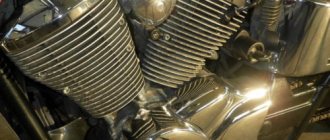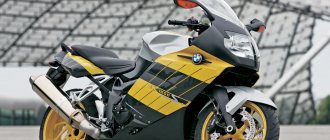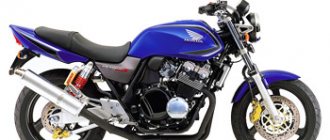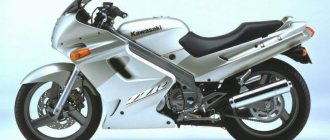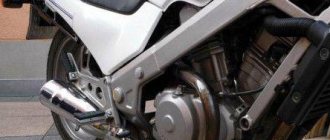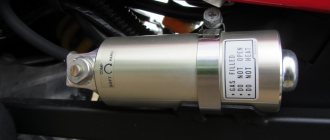The Japanese manufacturer Honda is well known in the motorcycle market to both professional riders and ordinary amateurs. Models of this brand are distinguished by the reliability of their components, powerful engines and original design. Some families of motorcycles have several generations, which confirms the high quality of these products. This series can also include the Honda VTR 250 model, the photo of which is presented below.
General information about the motorcycle
The model represents the classic performance of a road motorcycle. The development entered the market in 1997 and was aimed primarily at the Asian market. However, in 2009, the bike became available to Europeans, which motivated the creators to continue the development of the family. The design and overall construction of the model was initially distinguished by the presence of sporting features, which were interspersed with off-road characteristics. It is enough to note the slightly raised tail section and the dashboard, which looks reminiscent of the Italian Ducati-Monster line. But at the same time, the model also embodies many original qualities, which a review of the Honda VTR 250 and its technical and operational data will help you understand.
Specifications
The device has a traditional design, which ensures its practicality and reliability in operation. Again, the high service life of the parts, coupled with the original frame configuration, also affected the user-friendliness. Now you can take a closer look at the parameters of the Honda VTR 250. The technical characteristics of the motorcycle look like this:
- Dimensions – 204 cm in length, 72 cm in width and 105 cm in height.
- The height of the bike at the saddle is 78 cm.
- Ignition type – transistor.
- The gearbox is five-speed.
- Drive type – chain.
- The front brakes are 29.6 cm discs with a two-piston caliper.
- The rear brakes are disc brakes with a single-piston caliper.
- Front suspension - 4.1 cm with a telescopic fork of the Shova brand.
- The rear suspension of the motorcycle is implemented with a monoshock absorber with a progression of the Pro-Link system.
- Fuel tank capacity – 13 l.
- Weight – 139 kg.
Video
I found a very interesting article about Vetashka =)
It is not possible to review the entire Honda model range in a small article. And therefore, let’s focus our attention on one of the most interesting models, well-known and quite popular in the city. Honda VT 250. But... It was not in vain that we suggested stopping our gaze. In other words, just look. It is unknown what feelings this process will evoke: silent delight, rapturous awe or sincere bewilderment, but it is certain that no one will remain indifferent. The predatory, even aggressive profile of a sportbike, the high ground clearance of a road bike and the wide, coquettishly raised pipes, which are more characteristic of a classic bike, make it difficult to classify it into any category. The universality of use also does not add clarity to this issue. “Veteha” feels equally good on the highway, reaching speeds of up to 180 km/h (this is according to the speedometer, but in order to “fill up” the needle, you still need to accelerate), in the forest, where the long stroke of the shock absorbers allows it to even jump, and in the city , where its legendary maneuverability is simply irreplaceable. A high-speed neoclassic with the capabilities of an SUV is perhaps its most accurate definition. However, let's not lie. Any definition suffers from limitation. Ours, alas, is no exception.
Basics Now let's see what we have to deal with. The basis of any self-propelled vehicle is the engine. The Honda VT250 is equipped with a V-shaped (90 degrees) two-cylinder 4-camshaft 8-valve engine with liquid cooling and a 6-speed gearbox. Power – from 36 to 43 hp. depending on the model. I must admit, quite a good distribution of torque and power. It starts to pull almost from idle, a pleasantly surprising moment at medium and a calm pull up to 13,000 rpm. By the way, this is what allows you to safely drive both through the forest and off-road, as well as on the highway and on long trips. Frame – chrome-molybdenum solid-drawn tube, complex duplex. On the left is a removable section for removing the engine. This section of the frame also supplies coolant from the radiator to the pump, which reduces the length of the rubber pipe. The pendant deserves special mention. There are hydropneumatic fork stays at the front, Pro-Link at the rear (suspension with progressive characteristics) with a WP hydropneumatic monoshock absorber. The ability to pump air allows you to adjust the height of the rear shock absorber depending on the presence of cargo, passengers and the nature of the terrain. Brakes. Single-disc, two-piston ventilated Inboard brake at the front (a disc in the form of a ring secured by the outer diameter, the pads “grab” the disc from the inside and stand “inside” the ring) and a small-diameter drum brake at the rear. And finally, the wheels. They are prefabricated, Komstar systems (a disc turned and hardened from an aluminum-magnesium alloy, to which three pairs of boomerang-shaped plates are riveted, and a hub is already riveted to them). Such wheels are almost not afraid of impacts, and their weight is almost the same as cast ones. They stopped installing them, but not because of the backwardness of the design, but because of the complexity and high cost of manufacturing. It's a pity!
Protection and ergonomics No matter how unimportant the characteristics in the title may seem to some, we would venture to suggest that this is not entirely true. Minimum requirements for the safety and comfort of a motorcycle driver (we will refrain from defining “biker” or “motorcyclist”, too delicate a subject) are extremely necessary. Also because in relation to a motorcycle it is, without exaggeration, a matter of life and death. That is why Honda designers, like no one else, are concerned with this issue and their achievements in this area are obvious. The presented model clearly shows concern not only for safety while driving, but also for the moment when this movement is interrupted not at all by the will of the driver. The first is wind protection. She is really competent and thoughtful on a motorcycle. Despite its small size, it performs all the functions assigned to it. True, at a speed of over a hundred, the wind still makes life noticeably more difficult. And when accelerating to 150, in order to hide from oncoming traffic, it is best to just lie on the tank. In the event of a fall (of course, at low speed, for example, when turning), the driver has every chance of keeping his legs relatively intact. The fact is that installing iron tips on the steering wheel handles and bending the exhaust pipes leaves the driver’s foot in a deep niche when he falls. Without this, all 160 kg of metal would have neatly settled on the ankle, the sad consequences of which are easily predictable. And so everything is more or less safe. And some other little things. So, the motorcycle engine will not start if the speed is turned on. And if, on the contrary, the speed is too high (beyond 90 km/h), the red light on the instrument panel begins to blink. It does not interfere or distract, but its irritating effect makes you remember about safety. And maybe slow down. Speaking of the instrument panel. This is not to say that she is too rich. But quite informative and easy to read. Along with the obligatory speedometer, calibrated to 180 km/h, there is a tachometer (marked up to 13,500) and an engine temperature indicator. Plus, a number of lights indicate the neutral position of the gearbox, oil pressure, overspeed (!), and the inclusion of lights and turn indicators. The turn signals themselves are successfully mounted into the semi-fairing and rear pylon. Nothing sticks out, doesn’t stick out and, most importantly, doesn’t break when dropped.
Characteristics of the power unit
The bike is equipped with a two-cylinder four-stroke engine, the output of which, with a volume of 249 cm3, is 30 liters. With. There are conflicting opinions regarding the performance and thrust of the installation. On the one hand, the latest generations of the model demonstrate an order of magnitude higher productivity than previous generations. On the other hand, in the general segment, in terms of these indicators, the unit seriously loses to its competitors. This is largely due to the modest displacement of the 250 VTR engine. Honda notes that despite the low initial data, the power plant is still reliable and trouble-free in operation. And the practice of users, by the way, confirms this. In addition, experienced riders point to another positive aspect of using a low-performance engine - economical gas mileage. So, according to official data, the bike consumes only 2.5 liters per 100 km. Motorcycle owners talk about 3 liters on average, but this value also makes the model profitable in terms of fuel costs.
1988–1990[edit]
1990 Honda VTR250
The Honda Interceptor VTR250 was sold only in the United States from 1988 to 1990, with moderate changes occurring over its three model years. VTR250 with a 249cc, liquid-cooled, four-stroke, V-twin engine. 15.2 cc (15.2 cu in) and six-speed transmission was the smallest of Honda's Interceptor line of motorcycles.
The 1990 model had a 17-inch front wheel and front disc brakes were external.
Control and dynamics
The model feels confident in its natural environment – on the road surface. The device is not suitable for racing and off-road racing. A reliable motor ensures coordinated operation of the internal filling, which allows you to feel comfortable while moving. For this reason, many consider this motorcycle almost ideal for a novice rider. At the same time, the Honda VTR 250 has good dynamics – the maximum speed and acceleration characteristics are 160 km/h and 8 seconds to 100 km/h, respectively. It is worth noting that to increase safety when driving at high speeds, it is recommended to purchase a windshield. According to many owners, this accessory spoils the appearance of the bike, but for the sake of practicality and safety, it is better not to ignore such recommendations.
Differences between the Honda CBR 250 and its competitors
As mentioned above, among its competitors the model stands out with its memorable and eye-catching appearance in the style of the sports-touring Honda VFR 1200F. But that's not all the differences.
The 250 cc Honda is the only one in its class equipped with a combined anti-lock braking system. Previously, ABS was rarely installed on budget motorcycles and only as an option. Unlike Kawasaki, Honda has a 1-cylinder engine rather than a 2-cylinder engine.
Compared to its main competitor, the Honda is a motorcycle for beginners, easier to control and more forgiving of many mistakes. Kawasaki is a cool bike for experienced motorcyclists. It accelerates better, spins better, and gives the owner more driving thrills.
Modifications
Since the appearance of the motorcycle on the European market, the Japanese have updated the model several times, including increasing power. One of the most striking modifications is the VTR-F 250 version, in which the features of Italian bikes are most pronounced. True, the creators decided to leave the engine the same – with a power of 30 hp. With. Despite the similarity with Ducati models, the new version of the 250 VTR Honda is distinguished by its modest price tag, reliability and ease of maintenance. New technologies can also be seen in this device. In particular, the motorcycle received a liquid crystal display, above which, however, there is the usual stopwatch and tachometer in an analog version. As for structural improvements, the engineers reduced the saddle height to 74 cm. This is especially valuable for short riders. The latest developments in motorcycle technology have also appeared in the form of a catalytic converter with two oxygen sensors. The introduction of these systems was caused by the desire to comply with new environmental requirements.
Positive reviews about the motorcycle
The motorcycle segment was very dynamic even decades ago, but today some of its niches are completely taken over by fundamentally different categories of individual transport. However, there are many dedicated connoisseurs of classic road bikes. This category of users primarily notes the external data of the 250 VTR. Honda has retained the general design style, for which this model is mainly appreciated. Users place reliability and durability in second place on the list of advantages of this bike. Confirmation of the high resource of the element base is more than 10 years of operation of such motorcycles without major interventions in the design. Another thing is that many riders decide on tuning updates in accordance with the latest fashion. And from the point of view of modifications, the Japanese motorcycle also acts as a completely friendly base.
Exploitation
Buyers needed to be clear about where they would use the bike.
If it's mainly off-road conditions, the choice was ideal.
The Honda CRM 250 is absolutely not suitable for quiet and long driving on asphalt. If only because the tires here are cross-country.
In cases where you plan to drive on asphalt or compacted dirt roads with occasional off-road trips, you had to seriously think about the need to purchase this version. The developers went too far in adjusting the front brake support, so the front brake worked worse on asphalt than off-road.
Negative reviews
If you strictly approach the assessment of the model in the context of the capabilities of modern motor vehicles, you can find many weaknesses. This mainly concerns the power filling, the power of which only in some versions exceeds 30 hp. With. As the owners emphasize, this potential significantly limits the performance of the bike. At the same time, the outdated ergonomics of the Honda VTR 250 are also noted. Reviews, for example, criticize the creators for their reluctance to use electronic systems in new versions.


